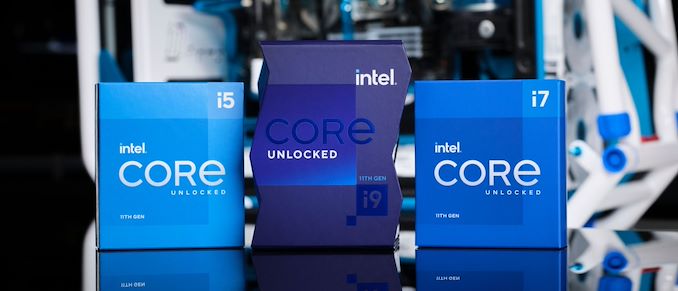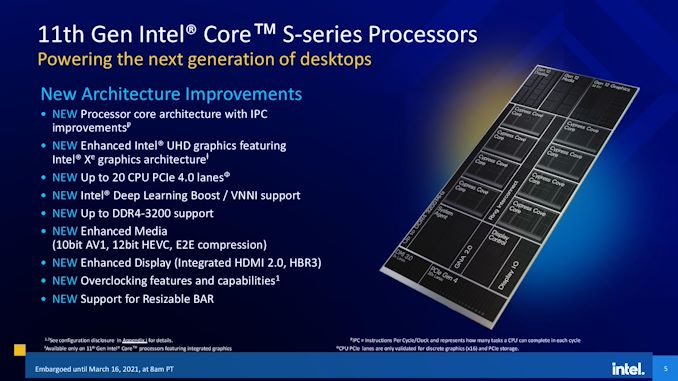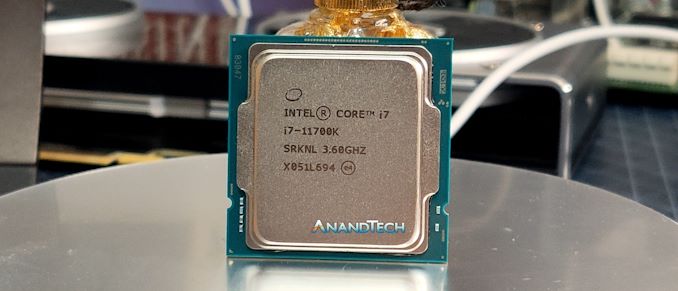Intel Launches Rocket Lake 11th Gen Core i9, Core i7, and Core i5
by Dr. Ian Cutress on March 16, 2021 11:00 AM EST
In the myriad of news and early reviews, Intel is today officially launching its 11th Generation Core family of desktop processors, also known as Rocket Lake, built on Intel’s most advanced 14nm process node technology. This new product family will form the basis of Intel’s premium desktop portfolio for most of 2021, if not longer, and features processors with up to eight cores. Highlights include the new microarchitecture, Cypress Cove, and the Xe-LP graphics design, both of which are redesigns of Intel’s 10nm mobile products. These parts also include Intel’s first PCIe 4.0 offering on the desktop, new AVX-512 for desktop, better memory support, support for resizable BAR, new overclocking features, and enhanced multimedia acceleration.
To The Moon With Rocket Lake
With Intel’s desktop processor launches, we typically observe that the new family is all pervasive, enabling products from the top Core i9 or i7 parts, all the way down to the Pentiums and the Celerons. Intel usually achieves this by building one, two, or more different sizes of silicon, often differing in cores and graphics to achieve the right balance of cost, yield, and performance.
For this generation, Intel has decided to only produce one size of silicon, and segment its offering, with the new family only being used for Core i5 and up.
This one-size silicon design features eight of Intel’s new Cypress Cove cores, with HyperThreading, and 32 execution units of ‘Gen 12’ graphics, derived from Intel’s newest Xe-LP graphics designs. Also bundled in that silicon is a DDR4-3200 memory controller, a PCIe 4.0 root complex offering 20 lanes for discrete graphics and storage, a double width DMI x8 link to the chipset, advanced AVX-512 support for Intel’s Deep Learning Boost technologies, updated overclocking, and next-generation media and display acceleration.
In the past, Intel’s Tick-Tock strategy meant that in each product cycle, either the process node would be updated (tick), or the microarchitecture would be updated (tock). The new Rocket Lake processors, with the Cypress Cove core, falls very much under the ‘tock’ nomenclature, however this core isn’t a completely new microarchitecture by the definition of the word ‘new’.
Backporting 10nm to 14nm
In order to enable Cypress Cove, Intel has taken its Sunny Cove core design built on 10nm, and re-architected it for 14nm. The process of doing this is what Intel coined as a ‘backport’. The process of backporting isn’t as easy as putting the core design on a photocopier and making it larger – the effect of the physics of electrons going through wires means that there are some inherent design criticalities in that process which deviate it a little. But on the whole, as our testing has already shown on our retail samples, despite the discussions about power, Intel has managed to keep 14nm Cypress Cove as close to the original 10nm Sunny Cove design as possible.
In a similar mantra, the new Xe-LP ‘Gen12’ graphics on Rocket Lake is also a similar backport. This time Intel has taken the graphics subsystem from its 10nm Tiger Lake notebook processors and crafted it into 14nm. As a notebook processor Tiger Lake focuses a lot on integrated graphics, and as a result has 96 execution units – Rocket Lake by comparison has only 32 units.
Backport vs Co-design
The future of how and when Intel will initiate additional backporting, even given suggested roadmaps, is likely to be in flux based on its ability to produce high single-core frequency desktop processors. Cypress Cove, by most measures, is a reflex response to a widening gap in Intel’s desktop roadmap, and takes a core specifically designed for a different process. Intel is/has/has likely learned a lot from this process, but in the future we can expect specific cores to be co-designed with both process nodes in mind. This is akin to Intel’s new stance on ‘enabling the right product on the right node at the right time’. A co-designed approach, rather than a post-production realisation a backport is required, will mean that future core designs that straddle two process nodes are likely to be more similar and optimized on both processes at the same time.
Rocket Lake: Core i9, Core i7, Core i5
The new Intel 11th Gen Core desktop processor family will start with Core i5, with six cores and twelve threads, through to Core i7 and Core i9, both with eight cores and sixteen threads. All processors will support DDR4-3200 natively, and offer 20 PCIe 4.0 lanes in supported motherboards – these lanes will enable graphics and storage direct from the processor, typically in an x16/x4 or x8/x8/x4 combination.
Both the Core i9 and Core i7 this time around have the same core count - normally the Core i9 would offer an obvious difference, such as more cores, but for this generation the difference is more subtle: Core i9 will offer higher frequencies and thermal velocity boost (TVB).
| Intel 11th Gen Core Rocket Lake Core i9 |
|||||||
| AnandTech | Cores Threads |
Base Freq |
1T Peak |
nT Turbo |
TDP (W) |
IGP UHD |
Price 1ku |
| i9-11900K | 8 / 16 | 3500 | 5300 | 4700 | 125 | 750 | $539 |
| i9-11900KF | 8 / 16 | 3500 | 5300 | 4700 | 125 | - | $513 |
| i9-11900 | 8 / 16 | 2500 | 5200 | 4600 | 65 | 750 | $439 |
| i9-11900F | 8 / 16 | 2500 | 5200 | 4600 | 65 | - | $422 |
| i9-11900T | 8 / 16 | 1500 | 4900 | 3700 | 35 | 750 | $439 |
At the top of the stack is the Core i9-11900K. Intel has set the 1000-unit pricing of the Core i9-11900K at $539. Note that Intel does this 1k unit pricing for OEMs, so the final retail price is often $10-$25 higher. This is well above AMD’s Ryzen 7 5800X at $449 SEP (MSRP), which is also an 8-core processor. Intel is stating that along with better gaming performance, this processor also offers next-generation integrated graphics, support for new AI instructions, and enhanced media support for the price differential.
On specifications, we knew most of the Core i9-11900K from a previous announcement, but today we learn that this processor has a base frequency of 3.5 GHz, alongside a peak turbo of 5.3 GHz in Thermal Velocity Boost mode, 5.2 GHz otherwise on the favored core, or 5.1 GHz on non-favored cores. The all-core frequency is 4.8 GHz in TVB turbo mode, or 4.7 GHz otherwise.
Thermal Velocity Boost is somewhat new to the desktop space, but what it means is that if the processor is under a certain temperature, it will add an additional +100 MHz frequency during turbo. In the case of the desktop processors, this temperature is 70ºC (158F). That being said, motherboard manufacturers are free to ignore this temperature level, and in our experience, almost all consumer/gaming motherboards disable that check and allow for TVB at all temperatures.
The only processor not getting TVB in the Core i9 family is the i9-11900T, which is the 35 W member of the family. This processor has 35 W on the box because its base frequency is 1.5 GHz, although it will turbo up to 4.9 GHz single core and 3.7 GHz all-core. These T processors typically end up in OEM systems and mini-PCs which are more likely to strictly follow Intel’s turbo recommendations.
All Core i9 processors will support DDR4-3200, and the specification is that the K/KF processors enable a 1:1 frequency mode with the memory controller at this speed, whereas the non K/KF run at 2:1 at DDR4-3200, or 1:1 at DDR4-2933 (more on this later).
| Intel 11th Gen Core Rocket Lake Core i7 |
|||||||
| AnandTech | Cores Threads |
Base Freq |
1T Peak |
nT Turbo |
TDP (W) |
IGP UHD |
Price 1ku |
| i7-11700K | 8 / 16 | 3600 | 5000 | 4600 | 125 | 750 | $399 |
| i7-11700KF | 8 / 16 | 3600 | 5000 | 4600 | 125 | - | $374 |
| i7-11700 | 8 / 16 | 2500 | 4900 | 4400 | 65 | 750 | $323 |
| i7-11700F | 8 / 16 | 2500 | 4900 | 4400 | 65 | - | $298 |
| i7-11700T | 8 / 16 | 1400 | 4600 | 3600 | 35 | 750 | $323 |
The Core i7 family includes the Core i7-11700K, which we have already reviewed with our retail sample, and tested on the latest microcode to date. This processor offers eight cores, sixteen threads, with a single core turbo of 5.0 GHz on the favored core, 4.9 GHz otherwise, and 4.6 GHz all-core turbo.
As noted in our review, the 125 W TDP on the box means little, as we saw 215-225 W peak power draw during turbo of AVX2, and 276-292 W peak power draw during AVX-512, and motherboard manufacturers often default to unlimited turbo in any event. Users going after any Core i7 or Core i9 product should look to a good air cooler or liquid cooler to get the best thermal performance here.
On the topic of memory support, the Core i7 family does support DDR4-3200, however Intel’s specifications is that any non-Core i9 processor should run at a 2:1 ratio of DRAM to memory controller by default, rather than 1:1, effectively lowering memory performance. This creates some segmentation between Core i9 and the rest, as for the rest of the processors the specification for DDR4-2933 is 1:1. Despite this technical specification, we can confirm in our testing of our Core i7-11700K that all the motherboards we have used so far actually default to 1:1 at DDR4-3200. It would appear that motherboard manufacturers are confident enough in their memory designs to ignore Intel’s specifications on this.
On pricing, the Intel Core i7-11700K is $399, which is important in two ways.
First, it is $140 cheaper than the Core i9-K, for the sake of only a few hundred MHz. That leaves the Core i9 high and dry on day one. Unless there’s something special in that chip we haven’t been told about that we have to discover come retail day on March 30th, that’s a vast pricing difference.
Second is the comparative AMD processor, the Ryzen 7 5800X, which has 8 cores and has a $449 SEP. If both processors were found at these prices, then the comparison is a good one – the Ryzen 7 5800X in our testing scored +8% in CPU tests and +1% in gaming tests (1080p Max). The Ryzen is very much the more efficient processor, however the Intel has integrated graphics (an argument that disappears with KF at $374). It will be interesting to see what recommendations people come to with that pricing.
| Intel 11th Gen Core Rocket Lake Core i5 |
|||||||
| AnandTech | Cores Threads |
Base Freq |
1T Peak |
nT Turbo |
TDP (W) |
IGP UHD |
Price 1ku |
| i5-11600K | 6 / 12 | 3900 | 4900 | 4600 | 125 | 750 | $262 |
| i5-11600KF | 6 / 12 | 3900 | 4900 | 4600 | 125 | - | $237 |
| i5-11600 | 6 / 12 | 2800 | 4800 | 4300 | 65 | 750 | $213 |
| i5-11600T | 6 / 12 | 1700 | 4100 | 3500 | 35 | 750 | $213 |
| i5-11500 | 6 / 12 | 2700 | 4600 | 4200 | 65 | 750 | $192 |
| i5-11500T | 6 / 12 | 1500 | 3900 | 3400 | 35 | 750 | $192 |
| i5-11400 | 6 / 12 | 2600 | 4400 | 4200 | 65 | 730 | $182 |
| i5-11400F | 6 / 12 | 2600 | 4400 | 4200 | 65 | - | $157 |
| i5-11400T | 6 / 12 | 1300 | 3700 | 3300 | 35 | 730 | $182 |
Another difference within these parts is that the Core i5-11400 and Core i5-11400T have UHD Graphics 730, not 750, which probably means that these are running 16 EU configurations, rather than 32 EU.The Core i5 spreads out a lot with more offerings, from $157 for the Core i5-11400F, up to $262 for the Core i5-11600K. All these processors have six cores and twelve threads, all have the traditional Intel Turbo 2.0, and all support DDR4-3200 (2:1) or DDR4-2933 (1:1).
Comet Lake Refresh: Core i3, Pentium
Rather than design a smaller piece of silicon on Cypress cove for the quad-core parts and below, Intel has decided to dust off the previous generation design and give it some updated frequencies. This means that none of the Cypress Cove improvements are in these parts, it is simply Skylake refreshed for a sixth iteration.
Everything here is still called 10th Gen, and it moves up +100 MHz or so compared to the regular Comet Lake parts. The refresh models are given the ‘5’ designation on the end.
| Intel 10th Gen Core Comet Lake Refresh Core i3, Pentium |
||||||||
| AnandTech | Cores Threads |
Base Freq |
1T Peak |
nT Turbo |
L3 MB |
TDP (W) |
IGP UHD |
Price 1ku |
| i3-10325 | 4 / 8 | 3900 | 4700 | 4500 | 8 | 65 | 630 | $154 |
| i3-10305 | 4 / 8 | 3800 | 4500 | 4300 | 8 | 65 | 630 | $143 |
| i3-10305T | 4 / 8 | 3000 | 4000 | 3700 | 8 | 35 | 630 | $143 |
| i3-10105 | 4 / 8 | 3700 | 4400 | 4200 | 6 | 65 | 630 | $122 |
| i3-10105F | 4 / 8 | 3700 | 4400 | 4200 | 6 | 65 | - | $97 |
| i3-10105T | 4 / 8 | 3000 | 3900 | 3600 | 6 | 35 | 630 | $122 |
| Gold G6605 | 2 / 4 | 4300 | - | - | 4 | 65 | 630 | $86 |
| Gold G6505 | 2 / 4 | 4200 | - | - | 4 | 65 | 630 | $75 |
| Gold G6505T | 2 / 4 | 3600 | - | - | 4 | 35 | 630 | $75 |
| Gold G6405 | 2 / 4 | 4100 | - | - | 4 | 65 | 610 | $64 |
| Gold G6405T | 2 / 4 | 3500 | - | - | 4 | 35 | 610 | $64 |
The key part in this family has always been the Core i3-10105F, offering a quad core processor equivalent to the Core i7-7700K for under $100.
On the next page, we discuss motherboard support, and the new overclocking features.













156 Comments
View All Comments
Conquest - Friday, March 19, 2021 - link
TDP is confusing, as its mean something totally different from AMD´s TDP.With this generation, there will be no problem to have 300W consumptation.
Oxford Guy - Friday, March 19, 2021 - link
No problem?dsplover - Tuesday, March 23, 2021 - link
How many years before Intel strikes back? Lucky for them old i7’s and Xeon’s were great CPUs and lasted me into 2021.They need a new design this year before they lose more customers to the innovative designs from AMD.
Lucky for them AMD APUs aren’t readily available.
fabrizioVR - Friday, March 26, 2021 - link
The question is : What is better 11700 K /11900 K or 10900 K for a Z490 motherboard ?MackMurder - Sunday, March 28, 2021 - link
I have serious question......I just ordered a Alienware Aurora r10 /w GTX 3080 and ryzen 7 5800x (over the i7-11700f)
Benchmarks were mostly identical. I went with the ryzen mainly because their supposed to be more efficient. But the TDP of the 11700F is 65 watts and the 5800x is 105 watts.
The AWr-10 case is known for heating issues (I will be replacing the fans with the more efficient quieter noctuas) but still want to have a processor that makes the lowest heat. I will be gaming in 1440p ultra wide and for hours on end usually. I'm only worried about heat.
I'm not a fanboy so don't care if I have red or blue, and have just come over to PC gaming after 15 years of Xbox.
I just want to keep my machine as cool as possible.
Any help is apreciated thank you
Mack
watzupken - Thursday, April 15, 2021 - link
TDP means nothing nowadays. AMD probably keeps closest to the rated TDP, while Intel is the worst offender for breaching the rated TDP when it comes to real world usage. Those competitive numbers you see in reviews, they usually results in the processor pulling in at least 2.5x the rated TDP for an i9 processor.